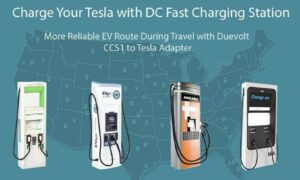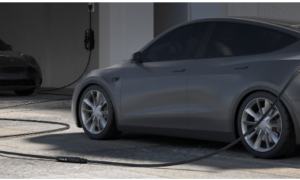The rapidly expanding global EV market is substantially fueling the demand for charging infrastructure. In the first half of 2024[1], global sales of new energy vehicles reached a new high with 7.279 million units sold, representing a year-on-year increase of 21.3%, and the market penetration rate has exceeded 17%.
As the number of EVs continues to rise, the gap in energy replenishment demand is also expanding, particularly in urban centers and along highways. In this context, the role of charging stations as critical infrastructure has become more prominent. Grid-connected solar charging systems that integrate energy storage technology with EV charging infrastructure provide an essential path to address current and future challenges.
Current EV Charging Challenges for Stations
1. High Costs
The construction and operation costs of electric vehicle charging stations are high, covering equipment purchase, installation, daily maintenance, and upgrades. In areas with low electric vehicle adoption rates, these costs pose significant barriers.
2. Limited Number of Charging Stations
Although the electric vehicle market is growing rapidly, the number of charging stations is still limited and unevenly distributed. Building a comprehensive charging network takes time and is influenced by various factors such as regional planning, infrastructure constraints, and capital investment.
3. High Energy Demand
EV charging places considerable pressure on the power grid, especially during peak usage periods. As the number of EVs increases, the grid’s load will further intensify, potentially leading to issues such as unstable power supply or outages. This not only affects EV owners’ charging experience but also poses a threat to the safe and stable operation of the entire grid.
4. Need for Charging Standard Upgrades
Current charging standards are unable to meet the requirements of new rapid charging technologies, and there are issues with incomplete compatibility regulations and a lack of relevant standards. This may lead to compatibility problems when different brands and models of EVs are charged.
Explore the Grid-connected Solar Charging System
1. The Principle of Grid-connected Solar Charging System
The grid-connected solar charging system achieves efficient energy management by storing grid electricity during off-peak hours and utilizing it when demand is high. This optimizes energy costs and ensures a stable power supply for electric vehicle charging without the need for solar panels or other renewable energy sources.
When an EV is connected and its battery is low, the grid supplies a maximum of 69kW (100A per phase) to the charger. The Power Conversion System (PCS) intelligently regulates this power to ensure it does not exceed the set limits. If the grid input power approaches or exceeds the 100A limit, the PCS will either increase the battery’s power output or reduce the EV charging power to maintain system stability. Once the EV is disconnected, the grid charges the battery back to full capacity, ready for future use.
2. The Advantages of Grid-connected Solar Charging System
- Enhance Energy Utilization Efficiency
Traditional charging stations, which draw power concentratedly during peak hours, can burden the grid. In contrast, grid-connected solar charging systems effectively reduce operational costs and improve energy utilization efficiency through peak shaving and valley filling strategies.
Furthermore, the integration of large-scale charging stations into the grid poses significant expansion pressures. However, the solar charging system can alleviate the impact of charging demands on the grid to a certain extent. It lowers expansion requirements for grid infrastructure by configuring reserve capacity to flexibly adjust charging power.
- Decrease Dependence on Conventional Energy
Integrating photovoltaic (PV) technology into charging stations can significantly reduce reliance on traditional fossil fuel-based power generation, such as coal-fired power plants. By harnessing abundant and clean energy from the sun, solar charging systems offer a sustainable alternative that minimizes the carbon footprint associated with electric power consumption for charging EVs, promoting green travel.
- Improve Power Supply Reliability
In remote areas or regions with weak grid coverage, grid-connected solar charging systems can serve as independent power supply units unaffected by grid failures, ensuring continuous power supply to charging stations. Even during power outages, the system can also safeguard basic charging needs for electric vehicles.
- Expanding Commercial Value
For commercial operators, grid-connected solar charging systems system deliver multiple profit models. Besides charging fees, they can also participate in grid peak shaving and frequency regulation auxiliary services to obtain corresponding revenue. Furthermore, with technological advancements and market maturity, the system can synergize with various other energy services, creating more business opportunities.
ATESS Advanced Solar & Energy Solutions
⮚ EVD-80/120/160/200D-X
The EVD-80/120/160/200D-X is a versatile, high-capacity DC fast charging station tailored for public use. With an expandable capacity ranging from 80kW to 200kW, it can swiftly add up to 100 kilometers of driving range to electric vehicles within just 5 minutes. This solar DC EV charger supports a wide voltage range of up to 1000V, ensuring compatibility with various electric vehicle brands and models. For user convenience, it offers multiple charging modes, including APP control, RFID (optional), and Plug and Charge functionality, making it an ideal choice for diverse charging scenarios.
⮚ PCS100/250/500/630
The PCS100/250/500/630, boasting an output power of up to 630kW per unit, provides robust support for EV charging. It operates stably without encountering restart issues, even when subjected to excessive inductive loads from EV batteries, thereby guaranteeing reliable charging performance. If one unit fails, the remaining units seamlessly continue operation, preserving the charging system’s continuity and reliability. Furthermore, in the event of a grid failure, the PCS100/250/500/630 can switch to a backup power source within less than 10 milliseconds, ensuring an uninterrupted power supply to the EVs being charged.
Case Sharing
The Agricultural Engineers Association (AEA) recently embarked on a significant upgrade of its existing EV charging infrastructure, which had previously relied on standard building facilities lacking specialized charging capabilities. Currently, the peak power requirement for the chargers stands at 300kW, a demand that the local grid alone cannot adequately meet.
To address this challenge, this AEA project adopts the ATESS grid-connected solar charging systems. In off-grid mode, the PCS utilizes batteries as the primary energy source to power the EV chargers. During startup, both the EV chargers and PCS accommodate surge power, which is absorbed by the batteries, thereby preventing any impact on the grid.
The implementation of ATESS’s grid-connected solar charging system in the AEA project has yielded notable economic, operational, and environmental benefits.
Conclusion
The swift expansion of the global electric vehicle market is prompting advancements in our charging infrastructure strategy, especially concerning EV charging solutions for commercial properties.
The ATESS grid-connected solar charging system presents a compelling solution to these challenges. By integrating energy storage technology with EV charging infrastructure, we can achieve efficient energy management, decrease operational costs, and strengthen the reliability of power supply. This system not only decreases our dependence on conventional energy sources but also promotes green mobility, aligning with global sustainability goals. Contact ATESS today to learn more about their grid-connected solar charging solutions.
Reference
- Available at:
http://jjckb.xinhuanet.com/20241011/f731aaaf52594ab3804ebf0ef0b61d9d/c.html



































